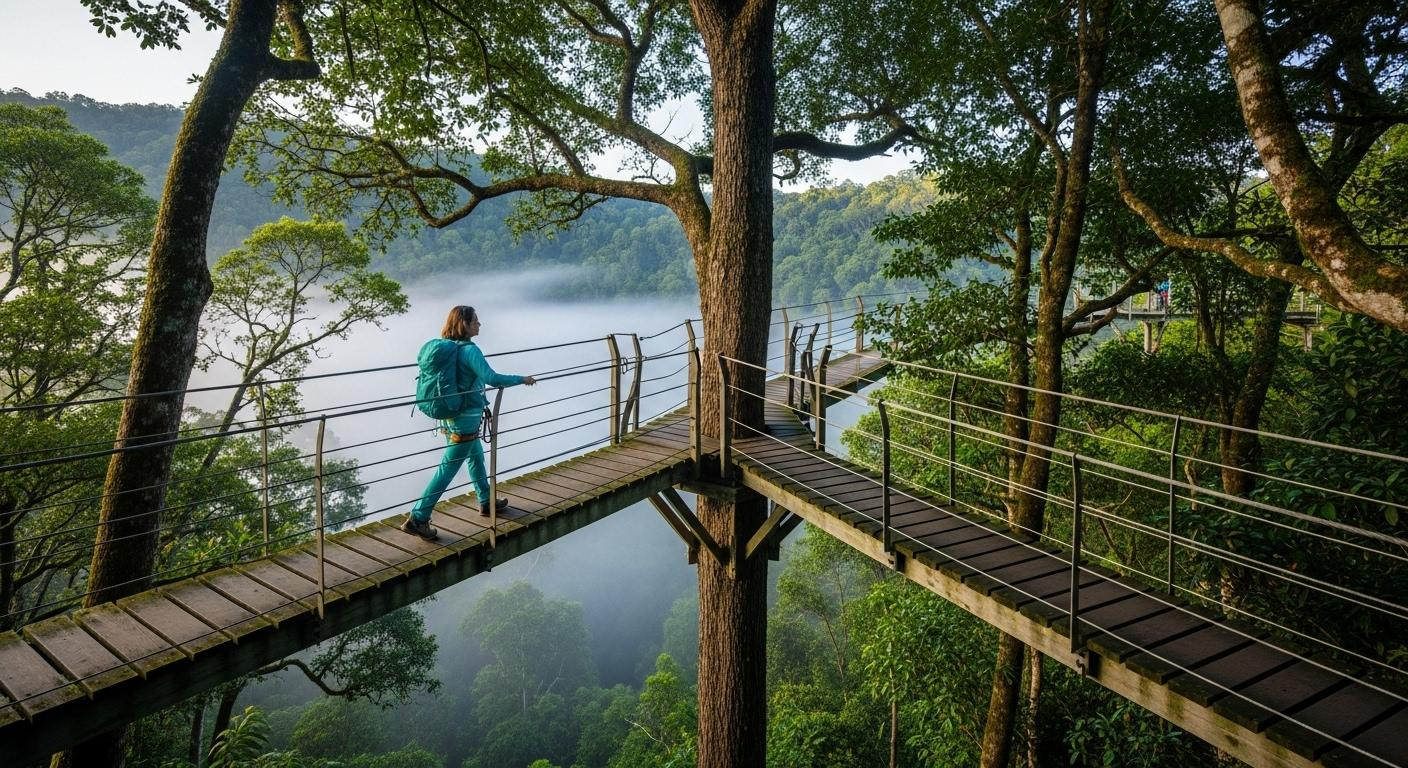No alarm clock pierces the silence at 5:30am in Danum Valley. Instead, hornbill calls echo through mist that has risen for 130 million years. I’d photographed rainforests across three continents, but nothing prepared me for stepping into Earth’s oldest tropical ecosystem. This isn’t Costa Rica’s commercialized canopy tours or the Amazon’s cruise ship circuits. This is Borneo’s 438-square-mile conservation area where fewer than 5,000 visitors annually witness what survived the ice ages.
The forest that survived ice ages
The 50-mile journey from Lahad Datu takes 3 hours on logging roads. Your 4×4 lurches through puddles deeper than most cars. Then the forest swallows you whole.
Borneo Rainforest Lodge emerges like a wooden ghost from the canopy. Elevated walkways connect chalets built around dipterocarp trees that tower 260 feet above. The architecture doesn’t fight the forest. It surrenders to it.
This isn’t tourism in any recognizable form. No independent trekking exists here. All 27 trails require guides who’ve studied these 130-million-year-old patterns for decades. Conservation here mirrors remote wilderness areas worldwide where local expertise protects both visitors and ecosystems.
What 90 feet above ground changes about perspective
The suspended world between earth and sky
Dawn at the canopy walkway rewrites your understanding of forest layers. You’re eye-level with hornbills whose wingspans stretch 5 feet. Golden light filters through mist as butterflies dance at 90 feet above ground.
The walkway sways just enough to remind you where you are. Each step forward reveals what ground-level hiking never could. Orchids bloom in tree forks. Flying squirrels glide between branches. The sounds change completely: cicadas buzz at eye level, gibbons call from neighboring trees.
Time moves differently here
Danum Valley survived multiple ice ages when most rainforests died. This ecosystem predates the Amazon by 75 million years. Indigenous Murut peoples have always known this place was sacred.
At nearby Coffin Cliff, wooden burial sites embedded in rock face tell stories older than written history. Research stations scattered throughout the valley study climate patterns, biodiversity, and carbon sequestration. Scientists return here for 30-year careers. Unlike mainstream hiking destinations, this place demands reverence over conquest.
The practical reality of reaching Earth’s oldest rainforest
Getting there: the multi-leg journey
New York to Kuala Lumpur costs $900-$1,500 and takes 20 hours. The domestic flight to Lahad Datu adds $150 and 2.5 hours. Then comes the crucial 4×4 transfer: $75 arranged exclusively through the lodge.
October offers optimal conditions. Daytime temperatures hover around 86°F with 80% humidity. Trails stay passable, wildlife congregates near water sources, and afternoon showers last minutes rather than hours. Strict visitor management limits access to preserve the ecosystem’s integrity.
What $500 per night actually buys
All-inclusive pricing at Borneo Rainforest Lodge ranges from $400-$600 nightly. This covers guided walks, canopy access, night safaris, and meals featuring wild-caught river fish with Sabahan spices. No budget alternatives exist inside the conservation area.
Power cuts off at 10pm. Air conditioning runs until then, but windows open to forest sounds afterward. Meals happen communally with other guests who traveled similar distances to reach this remote sanctuary.
The transformation you don’t expect
Three days here strips away modern noise completely. My most profound moment came at sunrise on the canopy walkway, completely alone with mist swirling below and the forest waking around me. You return not with Instagram trophies but with recalibrated humility.
While 45 million tourists jostle through Swiss Alps annually, fewer than 5,000 souls walk Danum’s trails each year. This conservation model contrasts sharply with mainstream Southeast Asian tourism where accessibility often compromises authenticity. The forest doesn’t perform. You simply exist within its 130-million-year continuum, briefly, quietly, changed.
Your questions about Danum Valley answered
What’s the best time to visit Danum Valley?
March through October offers the driest conditions with passable trails and active wildlife. October specifically provides ideal weather: tail end of dry season with fewer visitors than peak summer months. Avoid November through February when heavy rains make trails impassable and limit animal sightings significantly.
Can I visit Danum Valley independently or do I need guides?
All activities require guides with no independent trekking permitted. This strict policy protects the ecosystem and ensures visitor safety in terrain with leeches, steep drops, and potentially dangerous wildlife. Borneo Rainforest Lodge arranges everything: walks, night safaris, and canopy access through experienced local guides.
How does Danum Valley compare to Amazon or Costa Rican rainforests?
Danum’s 130-million-year forest predates the Amazon by 75 million years and hosts exponentially fewer visitors. While Costa Rica accommodates thousands daily and Amazon tours offer cruise ships, Danum limits access to preserve integrity. It’s quieter, more intimate, and demands significant effort to reach, but rewards with authenticity impossible in mass-tourism rainforests.
Dawn breaks again over dipterocarp crowns. Mist clings to ancient bark as gibbons call across the valley. You descend from the canopy walkway, boots touching earth that has supported life for 130 million years. The forest remains. You’ve changed.
